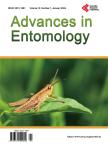Lack of Evidence for Local Adaptation of the Endangered Karner Blue Butterfly to Its Sole Larval Hostplant—The Wild Lupine
Lack of Evidence for Local Adaptation of the Endangered Karner Blue Butterfly to Its Sole Larval Hostplant—The Wild Lupine作者机构:Department of Biological Sciences Bowling Green State University Bowling Green OH USA
出 版 物:《Advances in Entomology》 (昆虫学(英文))
年 卷 期:2023年第11卷第3期
页 面:172-187页
学科分类:0710[理学-生物学] 07[理学] 09[农学]
主 题:Local Adaptation Karner Blue Butterfly Wild Lupine Butterfly Fitness-Related Responses Plant Genotypic Effects
摘 要:Local adaptation is an important process that drives the evolution of populations within species, and it can be generally expressed by the higher fitness of individuals raised in their native habitats versus in a foreign location. The influence of local adaptation is especially prominent in species that subsist in small and/or highly isolated populations. This study evaluated whether the federally endangered Karner blue butterfly, Lycaeides melissa samuelis (Lepidoptera: Lycaenidae) is locally adapted to its exclusive larval host plant, the wild lupine (Lupinus perennis). To test for local adaptation, individuals from a laboratory-raised colony were reared on wild lupine plants from populations belonging to either their native (Indiana) or a foreign (Michigan and Wisconsin) region. For this purpose, lupine plants from the different populations were grown in a common garden in growth chambers, and one Karner blue larva was placed on each plant. Fitness traits related to growth and development were recorded for each butterfly across populations. Days from hatching to pupation and eclosion showed gender-specific significant differences across wild lupine populations and plant genotypes (within populations). The percent survival of butterflies (from hatching to eclosion) also differed among plants from different populations. These results indicate that wild lupine sources can affect some developmental traits of Karner blue butterflies. However, growth-related traits, such as pupal and adult weight of individuals reared in plants from native populations did not differ from those of foreign regions. The apparent absence of local adaptation to wild lupine suggests that, at least, some individuals of this species could be translocated from native populations to foreign reintroduction sites without experiencing decreased fitness levels. However, future studies including more populations across the geographical range of this butterfly are recommended to evaluate other environ



